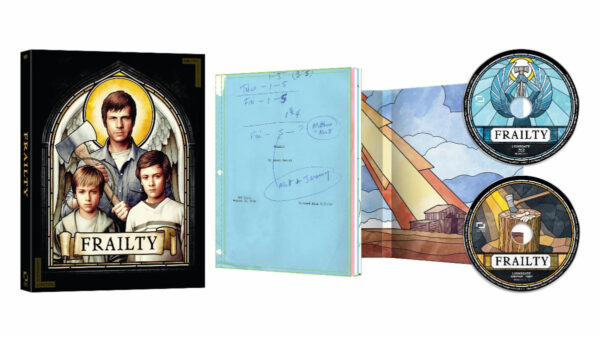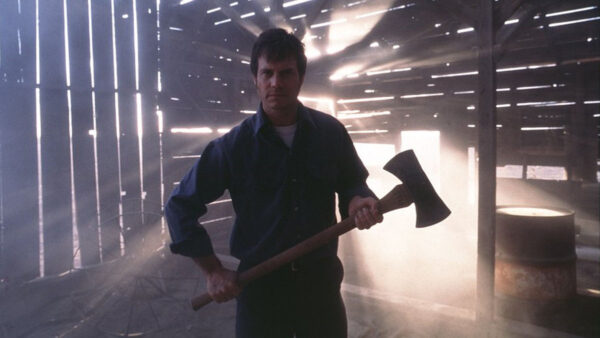
In 2001, actor Bill Paxton made his directorial debut with Frailty, a Southern Gothic religious thriller in the vein of Alfred Hitchcock about an unassuming father who hears the voice of God telling him to destroy demons.
The only catch: they look like ordinary people.
Frailty is a family drama told across two timelines: the present and 1979.
The present timeline acts as something of a bracketing device, though it is interspersed throughout the text as opposed to bookending it. The action begins with adult Fenton (Matthew McConaughey) confessing to FBI Agent Wesley Doyle (Powers Boothe) that his younger brother is the God’s Hand serial killer.
As Fenton tells his story, the action jumps back to 1979 to focus on a pre-teen Fenton (Matt O’Leary) and his younger brother, Adam (Jeremy Sumpter) and how their lives changed when Dad (Paxton) announced the family’s divine new religious mission.
While Fenton is the principal narrator of the story, it’s clear that the two boys have different reactions to their father’s quest. Where Fenton struggles with his faith and debates confessing everything to the Sheriff (Luke Askew), Adam is more willing to take their father at his word.

The film’s central conflict is also twofold: 1) there’s the childhood abuse inflicted on the boys by their father, who asks them to share his secret and participate in the murders, as well as 2) the debate about what is true.
Is it possible that Dad is really receiving divine visions? Or is he actually suffering from mental illness? Adding to the tension is the fact Dad sees the crimes of the victims when he touches them, but Fenton does not (Adam, meanwhile, claims he does, but the boy is at an impressionable age and clearly idolizes his father to the point of worship).
Screenwriter Brent Hanley mines plenty of drama from this dilemma, though the film falls into repetition in the second act as Fenton struggles with what to do. The last act is more successful because it focuses on the conflict between father and son, shifting the abuse from strictly emotional into a more physical realm. Dad targets Fenton for his lack of faith, forcing the pre-teen to dig a massive hole before trapping him in it and effectively starving the boy until he comes around.
Of course the film *spoiler alert for a nearly 25 year old film* has a twist ending that was de rigueur for the time. The climactic reveals that McConaughey’s adult Fenton is actually Adam and that he has carried on his father’s work riding the world of demons, including his older brother, who Adam frames for the recent murder spree. It’s a solid twist – if only because Hanley refuses easy answers about what is and isn’t true; unlike the ending of contemporaries like Identity (2003), the end of Frailty holds up nicely on repeat viewings.

The reality is that Frailty is much more of a family drama. Paxton’s direction can be a little workmanlike, although the film (which was shot by Jaws cinematographer Bill Butler) makes great use of light and darkness and the first time director incorporates a few memorable visual flourishes, such as a transition from a rainy car window to the pixels of a TV set.* As for gore, the violence frequently occurs offscreen (restrained is the word that comes to mind), though the bloodletting does escalate as Frailty moves into its climax.
*The transition and the scenes of McConaughey and Boothe in the car are vital enough to be the subject of Sundance Channel’s “Anatomy of a Scene”, which is included in the legacy featurettes.
The performances are the main selling point, including Paxton’s captivating and enigmatic role as the patriarch who cares deeply for his sons, but can’t help inflicting horrendous emotional damage on them. The two child actors are also excellent: O’Leary carries the bulk of the film’s dramatic weight as the stoic Fenton, while Sumpter’s childish innocence offers a nice contrast (and helps the twist to pack a bigger emotional wallop).
In one of the new featurettes, producers David Kirschner and David Blocker alternate between praise and criticism for the film’s distribution and box office. On one hand, they praise Lionsgate executives for trusting the dailies, keeping studio notes to a minimum, and generally taking a hands-off approach to filming. On the other, despite having confidence in the film, the producers suggest Frailty was “dumped” in April where it underperformed financially, grossing only $13M domestically.
The film was well-received and has achieved a cult status, but Frailty – along with other serious adult-oriented, genre-adjacent dramas such as Stir of Echoes – never got the accolades it deserves. The film is beloved to its niche audience, but the quality of the production merits a larger audience.
Hopefully this new release will help with that.

4K Extras
In addition to three legacy audio commentaries (one from Paxton; one from Hanley; and one featuring editor Arnold Glassman, producer Kirschner, and composer Brian Tyler) and a “Making of Frailty” featurette, the disc has divine art by artist Justin Erickson, includes a copy of Hanley’s script (!), and contains three new featurettes (none with subtitles unfortunately):
- Father Figure (34 minutes): This is most comprehensive of the new bonus features. It includes talking head interviews, some archival interviews, as well as behind-the-scenes footage from the shoot. A lot of time is spent reminiscing about (and celebrating) Paxton, including reflections from his son James Paxton, as well as O’Leary and Sumpter about his father-like mentorship on set. Plenty of interesting nuggets in this one.
- Establishing Shot with David Blocker (7 minutes): Producer Blocker walks us through the 4K restoration, which he took on in the wake of Paxton, Butler and Glassman’s deaths. Also featured are colorist Kostas Theodosiou (who worked on the original film) and re-recording mixer Tim Hoogenakker who were brought on to update the transfer and sound mix (respectively). Interesting, but a little technical at times.
- More Stories from the Frailty Set (18 minutes): This is a free-for-all grab bag of anecdotes and observations that didn’t fit into the other featurettes. They’re often brief, but provide some of the most fun moments in the extras, including Kirschner noting the film’s actual budget is $9M (not the $11M reported on Wikipedia) and a real-time reunion between Sumpter and O’Leary, who clearly haven’t seen each other in many years.
Frailty 4K is available for purchase now from Lionsgate
- Film: 4/5
- Disc: 4/5